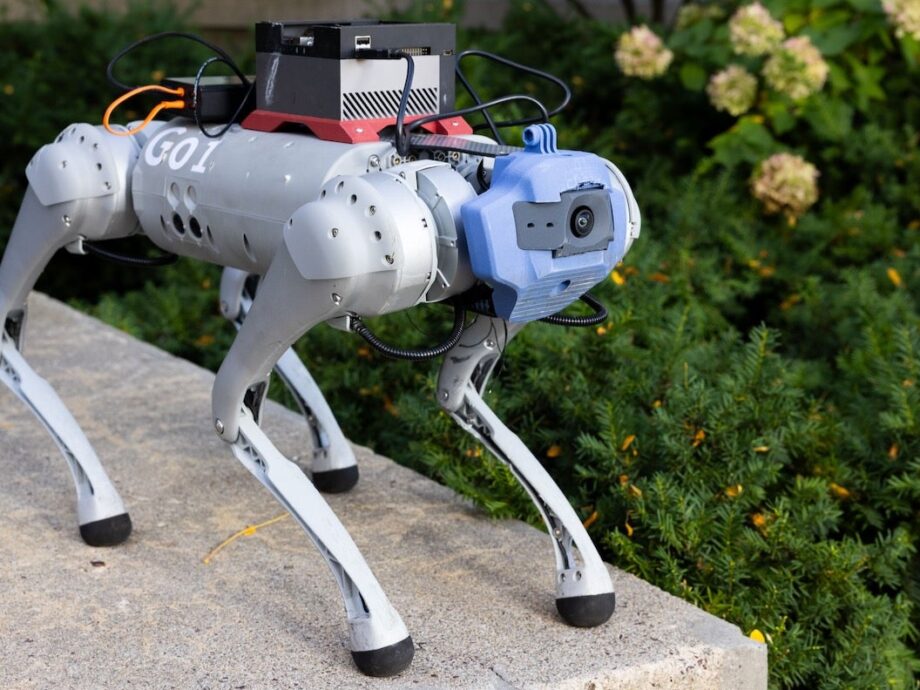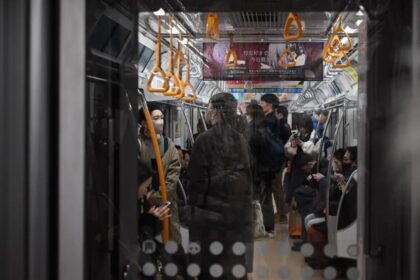A high tech welcome at Zhejiang University
Move in day at Zhejiang University’s Zijingang campus looked different this year. Instead of only volunteers and trolleys, new students found a team of robotic dogs greeting families, carrying bags, and even serving drinks. The showcase featured three models from DEEP Robotics, a company rooted in the university’s own research ecosystem. Lite3 units danced and entertained, X30 robots hauled heavy suitcases across stairs and stone paths, and a Lynx M20 with both wheels and legs zipped across flat ground then climbed steps without missing a beat. The scene mixed convenience with spectacle, and it underscored how quickly advanced robots are moving from lab demonstrations to everyday tasks.
- A high tech welcome at Zhejiang University
- Meet the robotic dogs
- How the machines see and move
- Students, parents and staff react
- From lab to campus to industry
- Other campuses roll out smart helpers
- China’s race to build faster, stronger robots
- Benefits and risks of robots on campus
- What this means for students and universities
- Highlights
Campus staff framed the deployment as practical help for a busy day and an early introduction to a culture of innovation. For parents, the machines turned a tiring morning into something light hearted. For students, they offered a glimpse of how cutting edge robotics can support real needs, from mobility and logistics to human robot interaction. For the university, the event spotlighted the strengths of Zhejiang’s robotics programs and partners, which now range from dancing quadrupeds to record chasing sprint machines.
Meet the robotic dogs
DEEP Robotics assigned a clear job description to each model. The goal was to show useful functions, not just tricks, and to keep the welcome lines moving. The three units share a common design philosophy, agile four legged motion, precise control, and steady navigation in crowded spaces. Each model adds a distinct capability that fits a campus environment.
Lite3, the crowd pleaser
Lite3 bots took on the role of the ice breaker. They danced to music and pulled off spins, jumps, and front flips that drew a circle of phones and smiles. The same balance and control let the robots carry trays and serve drinks without spilling. Under the surface, light frames, high torque joint modules, and motion control software made those moves possible. The control stack plans where to place each foot, times each step, and keeps the robot’s weight centered so it can cross small gaps or pivot to greet people smoothly.
X30, the hauler
The X30 units hauled what students could not. Each robot can carry about 85 kilograms of luggage, a load that would strain most volunteers. The machines took stairs, uneven stone, and curb cuts at a steady clip. They rely on multi sensor fusion, a method that blends data from cameras, depth sensors, and inertial units to detect obstacles and adjust the path instantly. That is how an X30 can see a rolling suitcase in its way, shift a step to the left, and keep pace without bumping anyone.
Lynx M20, the campus courier
The Lynx M20 adds wheels to the mix. On flat ground, it rolls fast like a small cart. At stairs or on slopes, it switches into legged walking for traction. That dual mode made it a natural courier between dorms and checkpoints. Students watched it roll over speed bumps and then walk up steps after a brief rain, holding balance on wet surfaces. The hybrid approach gives both speed and stability, a useful combination on a large campus with ramps, pavers, and stairs.
How the machines see and move
People often ask how a robot dog avoids tripping or spilling. The short answer is sensing, planning, and control. Cameras and depth sensors map the space in front of the robot. Inertial units help the machine feel its own motion, whether it is tilting forward or slowing on a slope. The software combines those signals into a clean picture of the world. Engineers call that multi sensor fusion. With that picture, the robot can recognize a curb, a suitcase, or a person’s leg and plan a safe route through a crowd.
The next part is motion control. Four legged gait control software decides which legs should be on the ground, which should swing, and how fast the body should move. High torque joints provide the force to push off, catch a landing, or hold a tray level while turning. The control system constantly shifts foot placement by a few centimeters to keep balance if the ground is slick or uneven. When the robot crosses a small gap or a bump, it adjusts step height and timing to prevent stumbles. This cycle of sense, plan, and act happens many times per second, which is why the dances look smooth and the drink service looks calm even in a crowd.
Hybrid designs like the Lynx M20 add a second mode of motion. Wheels reduce energy use and raise top speed on smooth floors. Legs take over for steps, gravel, or puddles. The control system must decide when to switch and how to manage traction. That choice depends on surface texture, slope, and route planning. The payoff is a robot that handles a wider range of real spaces without getting stuck.
Students, parents and staff react
The emotional response on campus was instant. Families stopped for photos. Volunteers smiled as an X30 took a heavy suitcase that would otherwise need two people on a staircase. The robots drew attention, yet they also made the lines move faster and freed human helpers for questions or directions.
Lin, a new student who arrived with a large bag, described the relief after watching an X30 take the load without a wobble.
It is really convenient. I cannot even imagine how exhausting carrying luggage would be without help from the robot. Zhejiang University has truly gone to great lengths to help us new students.
For the university, that sentiment was the goal. A polished welcome can set the tone for the first week. Using advanced machines to make that welcome smoother also signals what students can expect to explore in labs and classrooms.
From lab to campus to industry
DEEP Robotics traces its roots to Zhejiang University. The company was founded by Zhu Qiuguo, an associate professor connected to the university’s research community. That link matters. It shows how academic work in motion control and intelligent sensing can move into field tested products. The same control theory that keeps a Lite3 upright during a spin also helps an X30 climb a curb while carrying a box. Campus deployments let engineers watch real use, log data, and refine designs for crowded, messy spaces, not just test tracks.
China’s universities have become active hubs for translating robotics research into practical tools. Beyond welcome week, four legged units now help with inspection and mapping. In Shanxi province, a Lenovo built robotic dog worked with Tsinghua University’s School of Architecture to scan the Wooden Pagoda of Yingxian County. The robot gathered images and depth data for high precision models while minimizing contact with a fragile ancient structure. The project team used multimodal sensing and artificial intelligence to build digital twins that will guide future preservation work. That is a very different environment from a dorm walkway, yet the core abilities, stable movement and rich sensing, are the same.
Other campuses roll out smart helpers
Universities across China are deploying smart assistants at the start of the school year. Xi’an Jiaotong University introduced Jiao Xiaoxin, an AI powered chatbot that sits on the school’s AI innovation platform Jiao Xiaozhi. The service blends a knowledge base, workflow systems, and large language models to answer common questions, provide navigation, and suggest resources for new students. It is a digital front desk designed for the first week crunch.
There is also a physical face for the tech rollout. Xun Xiao, a humanoid robot developed by the university’s robotics institute, greeted students at campus gates, answered questions about network access at information desks, and walked people to specific service counters. The same robot appeared at the 2025 World Humanoid Robot Games in Beijing, where it demonstrated agile interactions across different scenes. These were small tasks and short conversations, yet they gave students confidence that robots can be helpful in less scripted situations.
Other labs are pushing toward assistive roles. A team at Northwestern Polytechnical University built a robotic guide dog that works entirely offline. The unit uses embodied AI, meaning the intelligence is inside a moving machine that perceives and decides in real time. It guided users through elevators, stairs, and street crossings without an internet link. The team combined model compression and accelerated inference to fit large models into a low power onboard computer. That approach could improve privacy and reliability in assistive robots for people who need consistent help, even where the network is weak.
China’s race to build faster, stronger robots
The welcome day dogs showed grace and control at walking speed. Zhejiang University researchers are also pushing the limits of speed. In May, a team at the university announced that its White Rhino quadruped completed the 100 meter dash in 16.33 seconds, a result recognized by Guinness World Records as the fastest official time for a four legged robot at the time of the announcement. The project applied a forward design approach and reinforcement learning to coordinate fast leg swings and real time balance. The group said the machine can also carry loads up to 100 kilograms, suggesting a path from running fast to running usefully in tough terrain.
Another effort linked to Zhejiang University focused on a sprint robot named Black Panther 2.0 from the startup Mirror Me, a Hangzhou based company founded by university faculty and graduates. Researchers reported that the machine ran 100 meters in under 10 seconds during tests and a broadcast, a mark that would beat many human sprinters, though it is separate from the White Rhino record recognized by Guinness. The Black Panther team drew inspiration from animal joints and paws. They fit springs at knee joints to absorb shocks, designed carbon fiber shins that boosted stiffness with a small weight increase, and added grippy running shoes shaped after cheetah claws. The team also referenced the Huygens coupled pendulum principle as a way to synchronize limbs into a unified gait, then layered machine learning to adjust foot timing on the fly.
Before the Beijing broadcast, team members described how quickly they moved from concept to working machine. Wang Hongtao, head of a related institute and a professor at Zhejiang University, highlighted the pace of development in a briefing reported by China Daily.
Through the integration of software and components, we created a prototype within a mere three months.
Jin Yongbin, a Zhejiang University researcher involved in the Mirror Me work, contrasted how animals learn to run with what robots must do.
Animals have experience from long term learning, but our limbed robots need to relearn with each step.
These projects, sprint robots and campus helpers, share a common thread. China is investing heavily to catch up and, in some areas, set the pace in robotics. Industrial robots already move parts in electric vehicle factories. Humanoid platforms are improving at dance and dexterity. Even the military has tested robot dogs in tactical videos, according to reporting by the Washington Post. Campus deployments are a visible, friendly end of that spectrum.
Benefits and risks of robots on campus
Robotic dogs can make a messy day more manageable. They reduce the physical strain on students and parents, cut the need for carts on stairs, and free volunteers for questions. They can carry first aid supplies or share directions through voice and screens. When tuned well, they move with predictable patterns that are easier to see and avoid in a crowd than a person zigzagging with two suitcases.
Practical concerns still matter. Human supervisors need to stay nearby in busy areas. Clear safety zones help when a robot stops or pivots. Slow, steady speeds work better than flashy moves when the goal is to move people through a gate. Battery swaps and charging need to happen away from queues. These points sound simple, yet they decide whether robots feel like helpful teammates or obstacles.
Cybersecurity also comes into play. Field Effect researchers reported in 2025 that some Unitree Go1 robots used by universities and labs had a hidden remote access path that connected to a tunnel service when the robots were online. With the right credentials, an outside party could have viewed camera feeds or issued commands. The manufacturer later disabled the service. That case is a reminder to treat field robots like any networked device that needs updates and good controls.
Practical safeguards that campuses and vendors can apply include:
- Keep firmware and software up to date and test updates before events
- Use network segmentation so robots sit on isolated Wi Fi or wired networks
- Require manual control overrides and clear emergency stop buttons
- Conduct security audits for any remote access services and camera streams
- Limit where robots collect video and keep clear privacy policies
What this means for students and universities
For new students, the welcome day demonstration is a first touch with applied robotics. It shows how control theory, sensing, and artificial intelligence can solve problems that are not confined to neat lab benches. For engineering majors, the machines offer a platform to study design choices, from joint motors to foot shape. For students in other fields, they serve as an introduction to human robot interaction, service design, and ethics.
Universities can expand from showcase days to practical pilots. Robots that carry packages can help with library transfers or lab sample runs. Units similar to Lynx M20 can inspect sidewalks and ramps for maintenance teams. Humanoid greeters like Xun Xiao can triage long lines during registration. These are incremental steps, each with a clear task and a human supervisor who can jump in if needed.
As China backs a nationwide push in robotics, universities will keep playing two roles. They are training grounds for the next generation of engineers, and they are living testbeds where new machines can prove themselves in real spaces. The Zhejiang University welcome day captured that dual role, with robots that entertained, carried weight, and left a clear impression on thousands of young people.
Highlights
- Zhejiang University used three DEEP Robotics models, Lite3, X30, and Lynx M20, to welcome new students
- Lite3 units danced and served drinks, X30 robots carried up to 85 kilograms, Lynx M20 switched between wheels and legs
- Multi sensor fusion and high torque joints helped the robots navigate stairs, stone paths, and crowds in real time
- Students praised the convenience, with one newcomer saying the robots made carrying luggage far less exhausting
- DEEP Robotics grew from Zhejiang University research, showing how campus labs feed real products
- Xi’an Jiaotong University deployed an AI chatbot and a humanoid greeter, while Northwestern Polytechnical University built an offline robotic guide dog
- Zhejiang University teams also work on speed records, with White Rhino setting a Guinness mark and Mirror Me’s Black Panther 2.0 reported under 10 seconds in tests
- Security researchers warned of hidden remote access in some robots in 2025, underscoring the need for updates, network limits, and manual overrides












